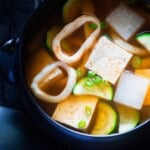Korean Squid Soup (Ojingeo Guk)
Light, savory, and full of comforting flavor — this Korean squid soup (Ojingeo Guk) is a homestyle favorite. Packed with tender squid and radish in a clean, umami-rich broth.
Servings: 4
Ingredients
Korean Soup Stock
- 10 g dried kelp (0.4 oz)
- 30 g dried anchovies (1.1 oz), heads and guts removed
- 6 cups water
Main Add-ins
- 2 small squid (about 240g / 8.5 oz total), cleaned and cut into rings or strips the size of an adult’s little finger
- 75 g zucchini (about 1/2 a zucchini), sliced into half-moons
- 300 g Korean radish (10.6 oz), sliced into even slabs, about 1cm (3/8inch) thick
- 200 g tofu (7 oz), (optional), sliced into even slabs
- 15 g green onion (0.5 oz), green part only, thinly sliced
- 1 1/2 Tbsp Korean soup soy sauce (guk-ganjang)
Soup Seasonings
- 1 Tbsp mirin
- 1 Tbsp Korean fish sauce
- 1/2 Tbsp minced garlic
- 1/2 Tbsp Korean chili powder (finely ground)
- 1 tsp Korean chili paste (gochujang)
- 1/8 tsp fine salt , or to taste
Instructions
- In a medium pot, combine the dried kelp and dried anchovies with 6 cups of water. Bring to a gentle boil over medium heat, then simmer for 10 minutes. After 10 minutes, remove the kelp — leaving it in too long can make the stock taste bitter. Continue simmering the anchovies for another 10 minutes to deepen the flavor. Once done, strain the stock and discard the solids.New to Korean stock? You can follow my full tutorial here: How to Make Korean Soup Stock
- Place the cubed radish in a bowl and season with Korean soup soy sauce (guk-ganjang). Let it sit for 10 to 15 minutes—this early step helps the radish absorb flavor, so each bite turns out more seasoned and delicious.
- While the radish is resting, mix the soup seasonings in a small bowl. Having them ready to go makes the next step quicker and easier.
- Bring the prepared soup stock (from step 1) to a boil over medium-high heat. Once it’s boiling, add the seasoned radish and the soup seasonings. Reduce the heat to medium and let it simmer gently so the flavors can meld.
- When the radish is about halfway tender, add the squid, zucchini, and tofu. Let everything simmer together until the squid is cooked through, the vegetables are tender, and the flavors have melded nicely.
- Taste the soup and season with a little salt, if needed, to suit your taste. Just before serving, garnish with chopped green onion. Enjoy hot with a bowl of steamed rice and a few simple Korean side dishes on the side.
Notes
My Best Cooking Tips
Taste the radish before using in the soup.Not all radishes are the same—some can taste bitter. If yours does, give it a quick blanch in plain boiling water (no seasoning) for 1 to 2 minutes before seasoning. Just be careful not to overdo it—over-blanching can make the radish too soft and affect the final texture of the soup. Using frozen squid?
Don’t thaw it all the way—it’s much easier to slice when still partially frozen, and less likely to tear or get mushy. Prep while the stock simmers.
While the soup stock is gently simmering, go ahead and prep the rest of your ingredients. It’ll keep things flowing smoothly and help everything come together more efficiently. If you want to learn more about Korean ingredients, check out my Korean ingredients post.
